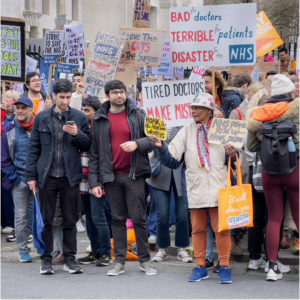17 year-old Ananya Prasanna explores why junior doctors are striking for better pay and conditions

March 13, 2023. First day of a three-day junior doctors strike in England over pay and work conditions.
June 13, 2024
NHS doctors at breaking point: long hours, low pay, physical and mental stress
I go past my local hospital every day on the way to school. Every few weeks, particularly around the spring of 2023, I would see an ocean of placards bobbing up and down outside the main entrance, with people chanting for higher pay.
When I arrived at school, I saw teachers standing outside the gate, handing out National Education Union stickers. Out of 100 people in my year group, around 30 came to school that day. “What’s the point?” they thought, considering they would get barely any lessons. With our GCSEs around the corner, pupils like me were worried.
This is the impact of public-sector strikes. Education stopped; healthcare workers not caring for patients, backlogs, longer waiting lists. But strikes are happening for a reason. To stop the strikes and bring back order to our government-funded services, we must address the root of the problem.
The British Medical Association (BMA) states that a crippling cost of living crisis, pay rises that are well below inflation and burnout are ‘driving hard-working doctors out of their profession’. With three-quarters of NHS GPs now wanting to go on strike, it is important to find a solution.
To understand why the NHS is crumbling, we must look at the many factors behind the strikes which show no sign of ending anytime soon.
Patient safety
Learn more:
A 2023 study by the Institute of Global Health Innovation (Imperial College London) found that the UK ranked 21st out of 38 countries for patient safety – a startling statistic. This was a factor cited at a Medicine Insight event I attended in March, when a junior doctor discussed why professionals like her supported industrial action.
She described working 12-hour shifts and being forced to treat patients in hospital corridors due to bed shortages, compromising patient privacy and safety. This stress was sometimes compounded by there being not enough staff working in a jam-packed emergency department.
Doctors are “striking for the patients,” she said, because this situation “is not safe” – refuting the notion that strikes are solely about pay. Although pay and working conditions are common reasons for striking, patient safety is an under-discussed issue that influences many doctors’ decisions.
Waiting lists and locum staff
The NHS will need £8.5bn over the next four years to tackle waiting lists, according to recent research. As a result of the increased waiting times, which have been caused by a multitude of reasons including a COVID-19-induced backlog and understaffing, the NHS has to postpone or cancel routine procedures, such as hip replacements. This results in patients looking for alternatives – namely, private healthcare.
But the cost of private health insurance is increasing and is already unaffordable for many. This leaves those who are unable to pay struggling in pain as they wait for NHS appointments. This situation is regressive and arguably contributes to both income and health inequality.
A common solution to staff shortages is to hire locum staff (temporary workers), typically for much higher pay than regular staff. For example, the Northern Care Alliance NHS Trust, as reported by the BBC, paid £5,200 for one locum shift by an agency doctor.
Although this system is often relied on to help fill vacancies and safely manage duties, some question whether it is the best solution. Locums, given that they are brought into environments they are not familiar with, are likely to produce a lower the quality of work compared to regular staff members.
The Cost of Living Crisis: Financial impact on young people
Cost of living crisis
The cost of living crisis has not helped the difficulties faced by the NHS. In a 2022 survey,the BMA highlightedhow some 80% of junior doctors have had to reduce the amount they spend on food shopping and cut down the amount of heating they use.
The Bank of England’s target for inflation is 2%. It currently stands at 2.3%,although it has peaked at 11.1% in the past two years – and wages have not risen to match this. While many industries are striking as a result of post-Covid inflation spikes, the BMA says that junior doctors are striking as a result of 15 years of below-inflation pay rises. Its figures show that pay for junior doctors has fallen by 26%.To reverse that, they requested a 35% pay rise.
Doctors’ pay includes compensation for difficulties they face in their line of work – for example, anti-social hoursand a lack of control over rostering. The conditions in the job are difficult, and coupled with the low pay, it is understandable how striking is acceptable.
Medical students spend at least five years as an undergraduate, longer than the vast majority, and accumulate a higher student debt, which is obviously difficult to pay off on a starting salary as low as £32,000.
The prospect of paying off thousands of pounds of debt can cause increased anxietyand incentivises taking on extra locum shifts to make ends meet. This, coupled with the emotional toll, understaffing, and an ageing population with complex health needs, can quickly lead to burnout.
Burnout
A 2018 study by the General Medical Council found that 81% of England’s doctors worked additional unpaid hours and that ‘excessive workload and the need to work additional hours creates work stress’. It also found that the risk of accidents increases with longer work periods, with the risk doubling when working a 12-hour shift rather than eight hours. It is clear this not only impacts doctors, but also endangers us as patients.
The study uses the term ‘work stress’, which impacts both physical and mental health. Nearly one in four doctors in training and one in five trainers faced burnout to a high or very high degree, and experienced exhaustion because of their work, according to the study. Chronic stress loads, leading to broken sleep patterns and long-term fatigue, means that more and more doctors are attending work while unwell.
Several studies including those from the BMA have found evidence that medical professionals are very likely to have mental health conditions, and also one of the highest suicide rates, due to the stress created by their long hours.
Fear of failure
To put this into context, the book (and subsequent BBC TV series) This is Going to Hurt: Secret Diaries of a Junior Doctor by Dr Adam Kay highlights the key issues those in the profession face. It contains diary entries written by Kay during his medical training in 2004–10. Significantly, the book delves into the political concerns within the NHS, and the societal conflicts between the public and neglected, under-appreciated doctors.
One thought-provoking sentence from the book is: ‘patients don’t actually think of doctors as being human’. If we were to ask what failure meant to a role, such as a news editor, you may think of answers such as a controversial article or uninteresting journalism. But what does failure mean to a doctor such as Kay?
Failure, to a doctor, carries a very different weight – it is the difference between life and death. In the words of palliative care physician Dr Rachel Clarke, “when death is your day job, you can’t flinch away”. What is expected of our country’s doctors is almost superhuman.
This is why our doctors are feeling the need to work longer, uncontracted hours, leading to chronic stress. This is why the NHS is under so much pressure.
Mental health concerns
Long working hours coupled with overtime, night shifts and unpredictable rotas are crucial barriers to the maintenance of physical and mental wellbeing. But being open about having mental health problems is not an easy option.
In such a competitive profession, being seen as anything less than perfect could put doctors at a disadvantage, which is why so many doctors keep their issues held deep down and suppressed.
A consultant, who asked to remain anonymous and suffers from mental health issues, shared with BMJ Careers that mental health issues in doctors are often recognised “far too late”. They added: “If I had a physical illness I could prove I had a problem. But if you have depression, people question your competence to do your job.”
Dr Vaish Kumar stands as testament to the depth of these issues. She committed suicide in 2022, after being constantly ‘belittled’ in a ‘hypercritical environment’ at a Birmingham hospital. In a plea to raise awareness and help other junior doctors, her parents released her final letter, sharing how the environment in which she worked “just broke me”.
Kumar’s story stands as a representation of so many doctors’ struggles, many of whom she helped herself.
Quitting and relocating
Four months into her dream job, which she had spent six whole years studying intensely for, junior doctor Piyal Modi quit due to burnout. With colleagues being off sick with COVID-19, alongside general understaffing, Modi found herself almost solely responsible for 100 patients with complex urological needs.
She joked about “treating people for UTIs in the urology ward [but] didn’t have the time to drink enough liquid herself to ensure that she was not in the same position”. The job became a risk to her mental and physical health, forcing her to leave.
Modi said that 40 of her colleagues had relocated to Australia or New Zealand, countries that recognise UK medical qualifications, but treat doctors with better pay and working conditions.
With the NHS funding the final year of medical school in the UK, it is financially draining to see people relocate or quit after their tuition fees have been paid for. But without improving conditions for staff, this will become a growing problem.
So what’s next?
The government has responded to strikes with multiple pay offers that the BMA have rejected. Hospital leaders are pleading with the government and trade unions to come to an agreement to end the action. The strikes are not over.
Junior doctors voted overwhelmingly in March to extend the strikes by another six months, meaning that the associated struggles will continue. At the end of May, they announced new strike dates in the lead-up to the general election on July 4.
Picket lines remain strong, with junior doctors even using strike days as an opportunity to donate blood. It seems that industrial action will not stop until pay is restored, a fight that junior doctors are determined to win.





